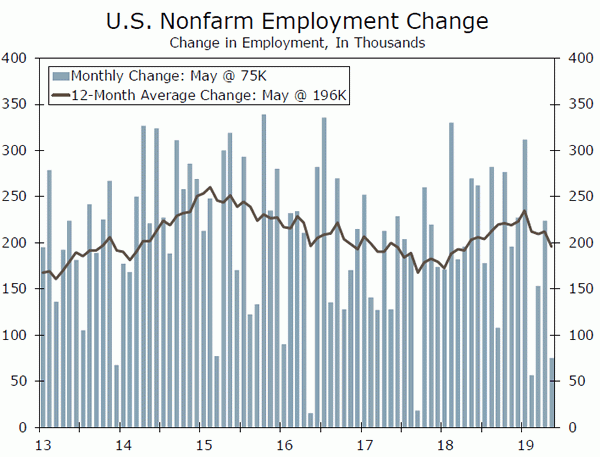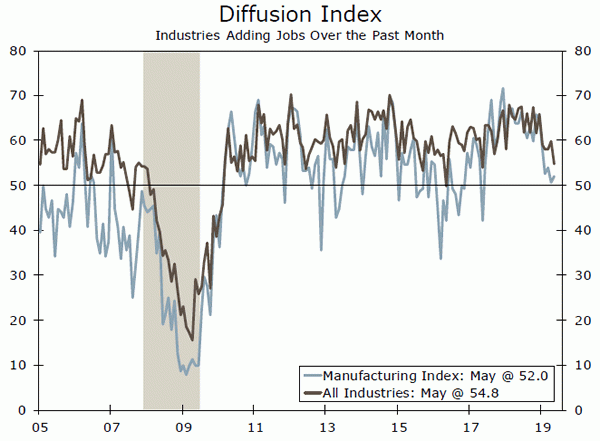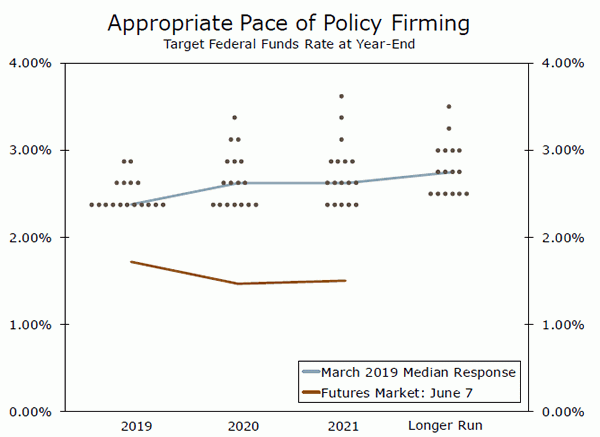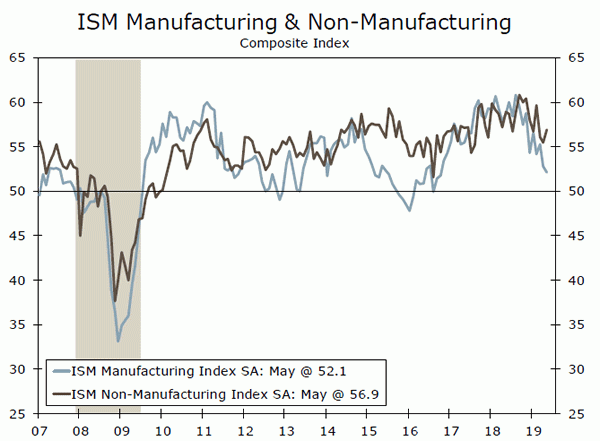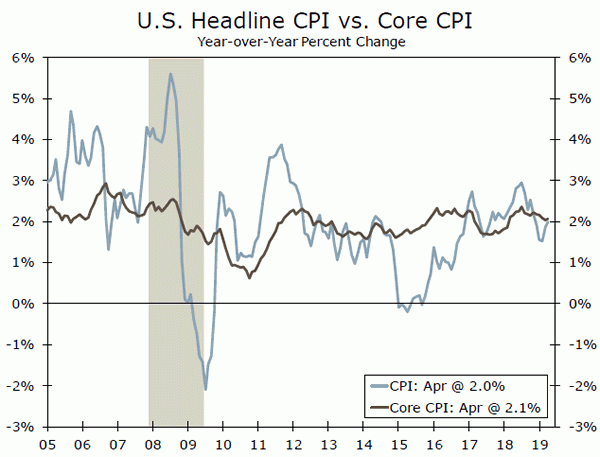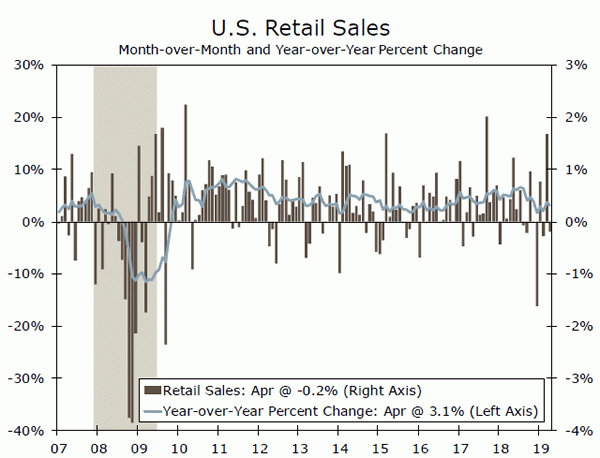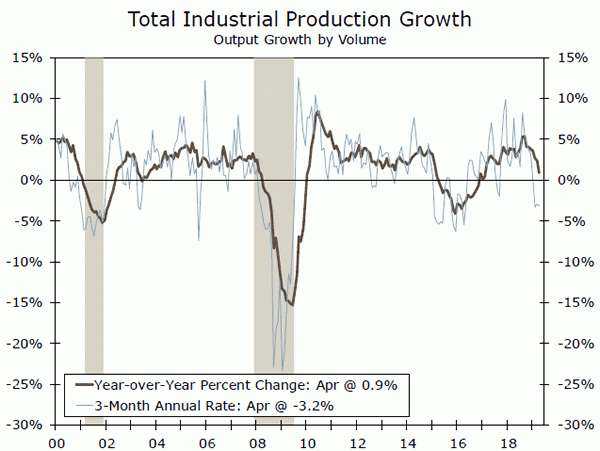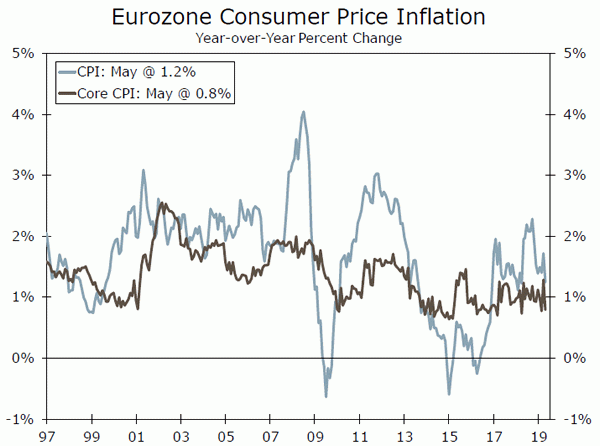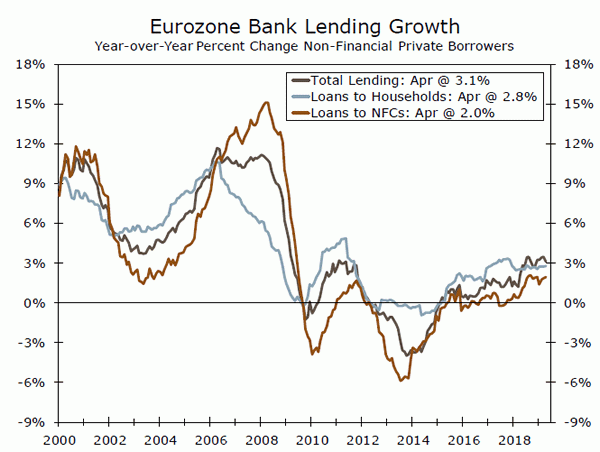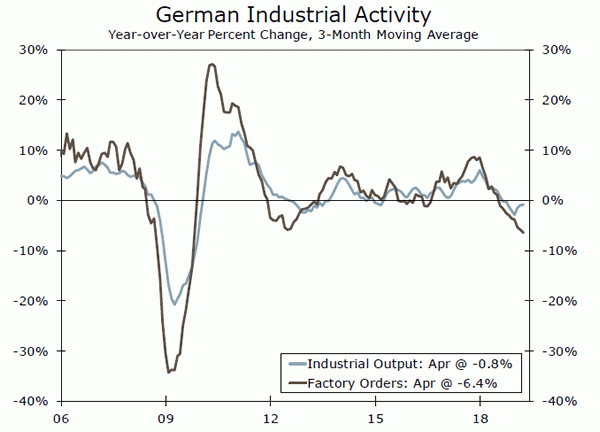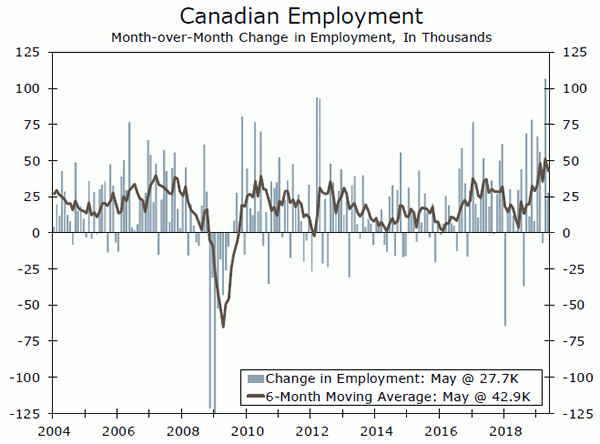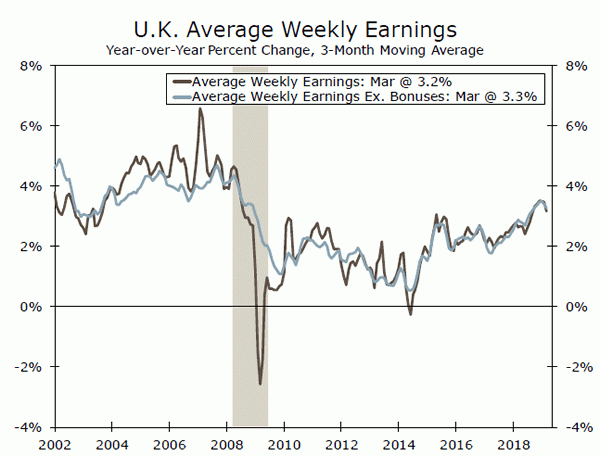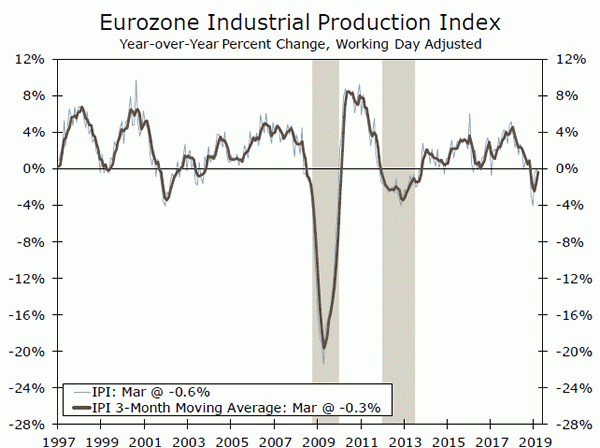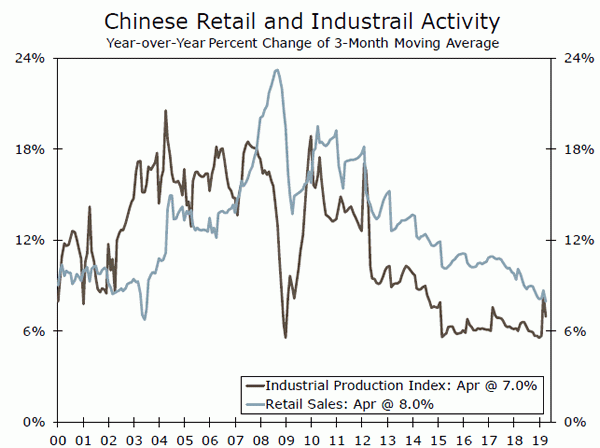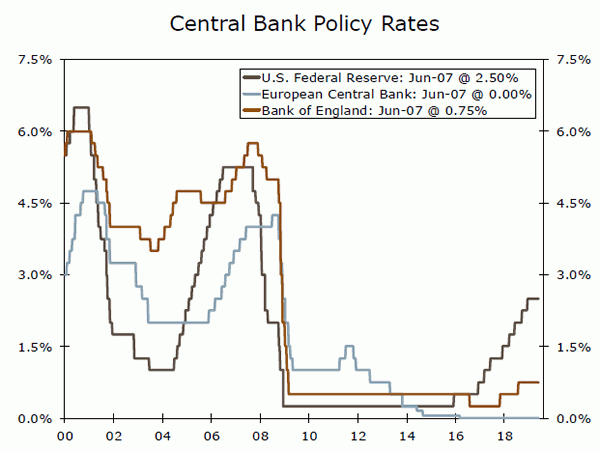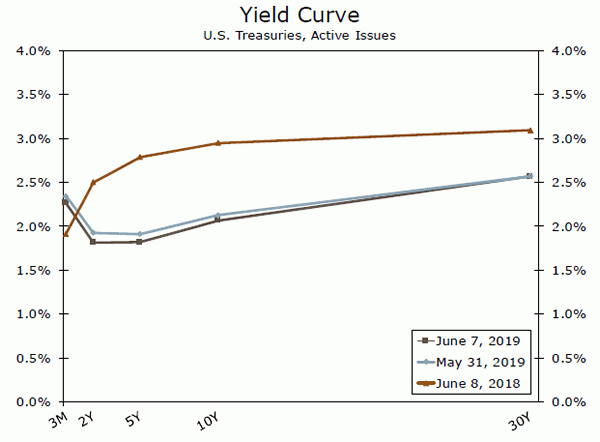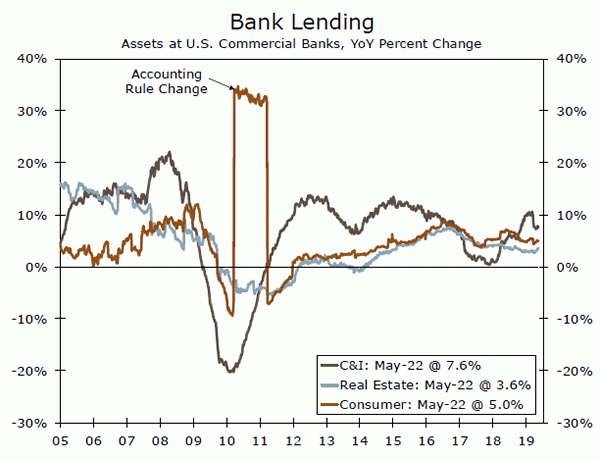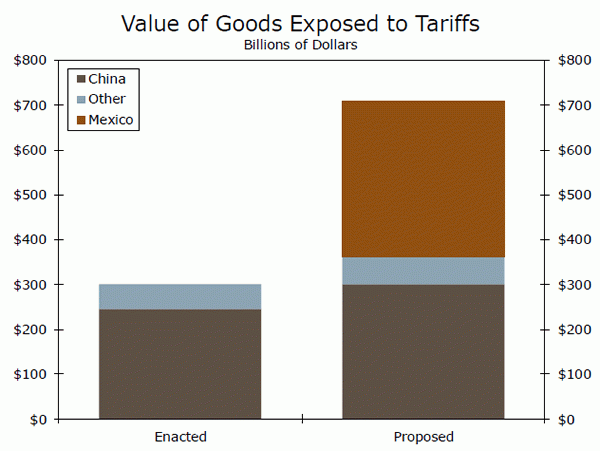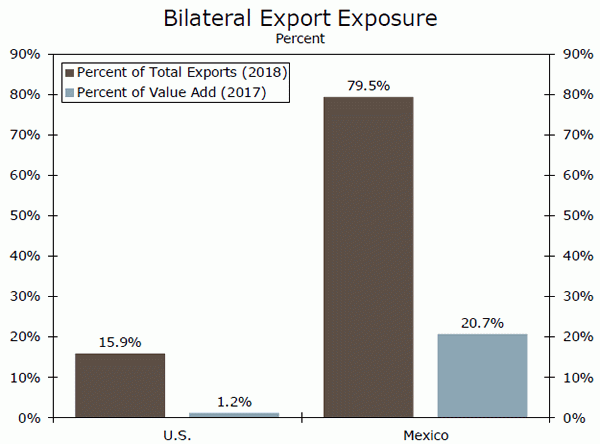U.S. Review
Growing Hints of a Slowdown
- In the midst of rising prospects of a prolonged and more pronounced trade war, data this week seemed to lend some credence to the idea that the domestic economy is beginning to succumb more materially to all the uncertainty.
- Nonfarm employers added just 75,000 jobs in May, while average hourly earnings also missed expectations, up 3.1% over the year, the slowest rise since September.
- The ISM manufacturing survey fell 0.7 points to a 31-month low of 52.1, while the non-manufacturing survey rose 1.4 to 56.9, offering some evidence of the ongoing divergence between the manufacturing and the much larger service sector.
Growing Hints of a Slowdown
In the midst of rising prospects of a prolonged and more pronounced trade war, data this week seemed to lend some credence to the idea that the domestic economy is beginning to succumb more materially to all the uncertainty. Nonfarm employers added just 75,000 jobs in May, missing even the lowest forecast, while downward revisions shaved off a further 75,000 from prior months’ reported gains. Average hourly earnings also missed expectations, up 0.2% on the month and 3.1% over the year, the slowest rise since September. The bond market reaction was swift; yields on both the two-year and 10-year immediately fell more than six bps, likely out of a belief that the growing hint of labor market weakness may force the Fed’s hand and induce a rate cut. Indeed, the market has come to view a cut this year as a foregone conclusion; futures markets have priced in around 75 bps of easing this year. A more defiant stance from the Trump administration towards China and the threat of a new volley of tariffs directed against Mexico are likely driving the pessimism and risk-off attitude. Despite high-level negotiations regarding the U.S.-Mexico border situation this week, 5% tariffs on all imports from Mexico are slated to go into effect Monday, and could rise as high as 25% by October. This latest escalation more than doubles the total value of goods subject to tariffs to around $700 billion and, perhaps more worryingly, brings into stark view the willingness of the administration to use tariffs as leverage for political or diplomatic concessions, dropping even the pretense of an economic rationale. See Topic of the Week for more detail.
The question for the Fed, then, is whether markets are overreacting to trade uncertainty by expecting three cuts in a 3.6% unemployment rate economy. Noted dove James Bullard kicked off the Fedspeak on Monday, stating that a cut “may be warranted soon”, and noted that even if growth does not succumb to trade tensions significantly, lower rates would help bring inflation up to target more quickly. Chair Jay Powell took the baton on Tuesday, saying, “We are closely monitoring the implications of these developments for the U.S. economic outlook and, as always, we will act as appropriate to sustain the expansion”. Markets took these comments and ran with them, as the S&P 500 surged 2.1% on the day and remained buoyant the rest of the week. We would suggest a more leveled view, as his comments are not anything new, per se. Expectations of a ‘Powell put’ may be a bit premature, if we resist reading into his comments too deeply, and in light of Robert Kaplan’s call for patience amidst trade threats that could be reversed as quickly as the president can tweet. John Williams similarly suggested staying on the path of data dependence. To that end, the ISM manufacturing survey fell 0.7 points to a 31-month low of 52.1, while the non-manufacturing survey rose 1.4 to 56.9, offering some evidence that the divergence between the manufacturing and the much larger service sector is persisting; in other words, the slowdown in the trade and global growth-exposed manufacturing sector has yet to spill over into the broader economy in a major way. Still, the majority of economic data lags. The cyclical parts of the economy are already slowing, and the uncertainty over the entire economy is already here.
U.S. Outlook
Consumer Price Index • Wednesday
For the second consecutive month, higher energy prices led to another solid monthly gain in the Consumer Price Index (CPI) in April, +0.3%. Outside of energy, price gains were more modest with the core CPI rising 0.1% on the month. The primary driver of weakness in the core CPI has been apparel price declines as a result of a source data change in the collection sample (-0.8% and -1.9% in April and March, respectively). Apparel—which constitutes roughly 4% of the core CPI—has had an outsized impact on core inflation in recent months despite its relatively small weighting. The influence of this data source change should begin to dissipate.
Looking to May, we project headline CPI to rise a more moderate 0.2% as energy price gains eased considerably last month. Excluding food and energy, the core CPI should register a trend-like 0.2% increase. We see little change to the overall trend in inflation as Fed officials prepare to meet later this month.
Previous: 0.3% Wells Fargo: 0.2% Consensus: 0.1% (Month-over-Month)
Retail Sales • Friday
Retail sales have experienced a volatile monthly performance so far this year. In April, headline sales unexpectedly slipped 0.2% on the month, following an exceptionally strong 1.7% gain in March.
We expect a rebounding performance in May, with headline retail sales increasing 0.7% (excluding vehicles, +0.4%). Motor vehicle sales increased 5.5% last month and should accompany an otherwise broad-based increase across the retail sectors.
Looking ahead, we remain constructive on the consumer and their contribution to overall economic growth. Fundamentals for sustained, solid consumer spending remain sound, including healthy hiring gains, low unemployment and firming wages. Assuming the labor market remains healthy, as we expect, consumer spending growth should be solid in the quarters ahead.
Previous: -0.5% Wells Fargo: 0.7% Consensus: 0.7% (Month-over-Month)
Industrial Production • Friday
Reflecting the ongoing, and now escalating, trade policy concerns, industrial production has fallen for the third time over the past four months. Manufacturing output contracted 0.5% in April, as production of motor vehicles & parts fell by the most in three months, while machinery output shrank by the most since 2014.
We look for a 0.1% decline in May total industrial production given there has been little relief in the factory sector data since last month. The headline ISM manufacturing fell moderately in May, though new orders showed some modest improvement on the month. Looking ahead, the manufacturing sector will continue to face the same issues seen over the past few months—namely, dealing with the challenges in trade due to the strong dollar and the need to slow inventory accumulation.
Previous: -0.5% Wells Fargo: -0.1% Consensus: 0.2% (Month-over-Month)
Global Review
ECB Hints At Easing for Ailing Eurozone Economy
- The European Central Bank announced policy this week, acknowledging that policymakers discussed rate cuts and restarting its asset purchase program. Those discussions come amid continued weakness in Eurozone economic data, including inflation well below target and ongoing concerns in Germany’s industrial sector.
- The race for U.K. prime minister is under way, while PMIs released this week signaled U.K. economic sentiment is anything but inspiring. Meanwhile, Canada had another banner jobs report in May.
ECB Hints at Easing for Ailing Eurozone Economy
It was a busy week for Europe. The European Central Bank (ECB) as expected, held its policy rates steady. As part of the announcement, it provided the terms of its TLTRO program of longer-term loans for banks, which were generally less favorable for banks than some had expected. The recent strength in bank lending in the Eurozone probably gave the ECB some leeway to be stingier with the lending terms, although those terms will still be fairly favorable as they allow for long-term loans to potentially be disbursed to commercial banks at negative interest rates.
Meanwhile, the central bank said rates would remain at present levels at least through the first half of 2020, whereas previously it had noted that rates would remain on hold at least through the end of 2019. ECB President Draghi noted that some policymakers had discussed rate cuts, and that there was scope for renewed purchases under its quantitative easing (QE) program. Those discussions come amidst ongoing economic weakness in the Eurozone, highlighted by some key data releases this week. Eurozone CPI inflation slowed more than expected to 1.2% yearover- year, while core CPI inflation slipped to 0.8%. Meanwhile, German industrial output unexpectedly fell 1.9% on a sequential basis in April. Despite ongoing economic weakness in the Eurozone, we are not yet convinced the ECB will restart QE or cut rates anytime soon. However, with the change in forward guidance, we now see substantial risks that the ECB will not raise rates in Q1-2020 as we currently expect.
Last but not least, Italian political concerns escalated this week after the European Commission recommended a formal procedure to rein in Italy’s budget deficit and debt-to-GDP ratio, which it views as in violation of the E.U. budget rules. To sum up, ECB policy is likely to remain accommodative for some time amid a soft domestic growth and inflation backdrop and ongoing political concerns in the region.
Elsewhere, the race to replace U.K. Prime Minister Theresa May kicked into gear this week, as the field of candidates narrowed slightly and candidates began formalizing their stances on Brexit and other issues. Reports indicate the Conservative Party is seeking to conclude the leadership race by July 26. U.K. domestic economic data this week were mixed but pointed to weak economic sentiment. The May manufacturing PMI fell to 49.4, the lowest since July 2016, while the services PMI rose to a still-low 51.0. The U.K. manufacturing sector is likely reaping the impact of overbuilt inventories earlier this year, although the services sector has probably been more resilient than sentiment figures currently suggest. Finally, there was some focus on Canadian labor market figures, which were generally stronger than expected. Employment rose 27,700 in May with all the gains in full-time jobs, following the largest increase on record in April (+106,500). The other details of the report were also constructive, as wage growth remained solid at 2.6% year-over-year, while the unemployment rate fell to 5.4%.
Global Outlook
U.K. Labor Market Report • Monday
The U.K. economy has been surprisingly resilient in the face of Brexit uncertainty, as real GDP grew 0.5% in Q1 (not annualized) on solid domestic demand growth. That solid domestic economic picture is also reflected in the labor market, where wage growth remains solid, the unemployment rate is at a multi-decade low and employment growth is strong.
In our view, the most important metric to watch in next week’s labor market report is wage growth, which has tapered off a bit recently but generally remains near the highest levels of the cycle. Unit labor costs, which adjust wage growth for the productivity of workers, has picked up meaningfully, suggesting the rise in wages is not entirely reflective of increases in productivity. We suspect the Bank of England is watching these developments closely, and while Brexit uncertainty probably means no rate hikes are coming soon, rising cost pressures could eventually force the central bank’s hand.
Previous: 3.2% Consensus: 3.0% (Year-over-Year, 3-MMA)
Eurozone Industrial Output • Thursday
The Eurozone’s economic woes seemingly have yet to meaningfully abate, but next week’s reading on industrial output from the bloc will offer some insight into whether that story has changed. The industrial sector has languished, particularly in Germany, as weaker global trade has dinged the export-sensitive economy. Output in the industrial sector has recovered a bit in recent months, but Germany’s industrial output reading this week shows that the recovery may have stalled.
The recent increase in trade tensions only adds to the downside risks for output, particularly if tensions linger or worsen in the months ahead. On the bright side, retail sales have picked up recently as inflation remains low, and ultimately we remain of the view that the Eurozone will dodge a full-scale recession. Still, our full-year 2019 forecast for Eurozone GDP growth is just 1.1%, hardly an inspiring outlook.
Previous: -0.3% Consensus: -0.4% (Month-over-Month)
China Economic Activity • Friday
China releases industrial output and retail sales figures for May next week, and these numbers will provide our first look at whether the recent escalation in U.S.-China trade tensions has had any discernible impact on Chinese activity. The manufacturing PMI fell further into contractionary territory last week (49.4), which may bode poorly for industrial output, although the non-manufacturing PMI continues to be more resilient and remains comfortably above 50. Next week will also feature the release of Chinese trade data for May, which will also encapsulate the period since the United States raised tariffs on US$200B in goods. Ironically, the tariffs could pose upside risks for Chinese exports to the United States if firms in China rushed to send off shipments before the tariffs took effect. Finally, there could be a relatively swift reaction from Chinese authorities, including pledges to ease monetary or fiscal policy, if any of next week’s data releases are particularly underwhelming.
Previous: 5.4% (Industrial Prod.) & 7.2% (Retail Sales) Consensus: 5.4% & 8.0% (Both Year-over-Year)
Point of View
Interest Rate Watch
The Bond Market Looks Prescient
The May employment data drive home many of the points we made in this column last week, namely that the inversion of the yield curve is for real this time. With both the 2-year and 10-year Treasury yields below the federal funds rate, the bond market has put the Fed on notice that their near-term and longer-term forecasts for U.S. economic growth are too optimistic. This morning’s weaker employment report, which showed nonfarm payrolls adding around 100,000 fewer jobs than the consensus estimate and downward revisions to the prior two months data, reinforced that message and very likely removed any lingering doubts that the economy has slowed.
The financial markets are now pricing in two or three quarter-point cuts in the federal funds rate this year. That is probably too much. Part of this morning’s smaller job gain was simply a payback for the exceptionally strong April data. The devastating flooding in the Midwest appears to have bolstered hiring in heavy engineering, possibly to shore up levees. Hiring also rose sharply in social services, particularly areas providing disaster assistance. Seasonal adjustment likely magnified the impact last month and the May data saw some mean reversion. The relatively late May survey period also meant a large number of teachers, both in government and the private sector, fell off of payrolls this past month. The bottom line is job growth has moderated but perhaps not as much as the May data suggest.
Bond yields retreated following the jobs data. The financial markets are concerned about the implications of a widening trade war and the possible near-term distortions from even a short period of tariffs on imports from Mexico. If a deal can be reached with Mexico before tariffs are put in place, yields will likely rise, as that would likely keep the Fed on hold for a few more weeks. Policymakers also need to determine how much damage tariffs on Chinese imports and the threat of tariffs on Mexico has already done to the economy. Risk aversion has undoubtedly increased, which raises the hurdle rate for every additional investment dollar and new hire.
Credit Market Insights
Italy’s Credit Vulnerability
On Wednesday, the European Commission released a report that recommended disciplinary proceedings against Italy, over its failure to follow European Union (EU) debt rules. The Commission concluded that an excessive debt procedure (EDP) is warranted and the report marked the first step in the EDP. Next, the analysis will be submitted to EU members to discuss their opinions on the commission’s proposal over Italy’s budget. If EU members are unsatisfied with Italy’s ability to reduce its debt based on the recommendations, the country may face fines up to roughly €3.5B (0.2% of GDP).
According to EU rules, Article 126(2) TFEU states that, in order to be in compliance with budgetary discipline; no country should have a government deficit larger than 3% of or government debt exceeding 60% of GDP. According to the report, Italy did not comply with the debt reduction benchmark last year. In 2018, Italy’s gross debt rose to 132.2% of GDP, above the 60% reference value, however its deficit remained within the 3% limit. The Commission forecasts Italy’s debt-to-GDP will reach even higher levels in 2019 (133.7%) and 2020 (135.2%), while in 2020, the general government deficit is projected to exceed the reference value.
Italy’s mounting public debt has left its economy vulnerable. In the second half of 2018, Italy’s nominal GDP growth dipped below 2%, hindering its ability to reduce its public debt at a faster rate.
Topic of the Week
The Latest Front in the Trade War: Mexico
What’s Happening: U.S. and Mexico officials have yet to reach a deal on illegal immigration. Unless negotiators make major progress, tariffs on goods coming into the United States from Mexico will be subject to a 5% tariff starting this Monday, June 10. There is a built-in escalation of five percentage points each month until the tariff rate hits 25% on October 1.
Why it Matters: Tariffs on Mexican goods would mark the biggest escalation yet in the ongoing trade war. The dollar value of goods currently subject to tariffs totals about $300 billion. The proposed tariffs on Mexico would affect an additional $346 billion of goods coming into the United States. This is more than just a new front; it is a more than doubling of the trade war in one shot.
Mexico is the second largest market for both U.S. imports and exports. Last year, the share of total U.S. exports to Mexico was just 15.9%. A big number, but it pales in comparison to the 79.5% share of Mexican exports destined for the United States. Exports to Mexico comprise only 1.2% in terms of value added in the U.S. economy. So at least in terms of the bilateral trade relationship, Mexico has more to lose than the United States. The auto industry accounts for more than a third of U.S. imports from Mexico. This large share and the interconnectivity of North American supply chains suggest the auto industry is at heightened risk from tariffs.
Our Takeaway: By itself, a trade war with Mexico would not plunge the U.S. economy into recession. But, coupled with the other tariffs, it is likely to weigh on U.S. growth. While we suspect there is not much support for these policies on either side of the aisle that may not prevent the tariffs from going into effect next week or escalating in subsequent weeks. Should these measures go into effect, the economic pain they will cause, particularly in the auto sector, will likely make this a politically untenable plan in the longer run.




